

Map human heart. Basic Genetics. Grades 6 to 8: Human Body Series - KidsHealth in the Classroom. Human Digestion Demonstration - The Bread In The Bag. Microbes, not food restriction, could be the key to our most effective treatment for obesity. Gastric bypass surgery is the most effective way for those with morbid obesity to lose weight, but new research has confirmed that there could be more to the procedure's success than just limiting food intake.

It seems the bypass also swaps the ecosystem of microbes in the digestive system for one that increases weight-loss, posing a potential way to achieve bypass's benefits without its risks. Best of all, this new assortment of gut bugs sticks around, helping patients lose weight long after the surgery. In 2008, researchers from Arizona State University found the types of bacteria in the digestive systems of patients after they'd had a form of bariatric (weight-loss) surgery called a Roux-en-Y gastric bypass had changed dramatically, leading them to wonder if these new microbes might be at least partially responsible for ongoing weight loss. With a tiny sample size of just three study groups containing three individuals each, it was hard to draw any solid conclusions.
Scientists turn mammalian cells into complex biocomputers. Computer hardware is getting a softer side.
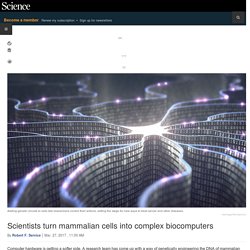
A research team has come up with a way of genetically engineering the DNA of mammalian cells to carry out complex computations, in effect turning the cells into biocomputers. The group hasn’t put those modified cells to work in useful ways yet, but down the road researchers hope the new programming techniques will help improve everything from cancer therapy to on-demand tissues that can replace worn-out body parts.
Engineering cells to function like minicomputers isn’t new. As part of the growing field of synthetic biology, research teams around the globe have been manipulating DNA for years to make cells perform simple actions like lighting up when oxygen levels drop. To date, most such experiments have been done in Escherichia coli and other bacteria, because their genes are relatively easy to manipulate. Scientists have tried to extend this to mammalian cells to create genetic circuitry that can help detect and treat human diseases. Watching plants grow has never been this exciting.
It’s hard to take a picture of something that’s always moving—just ask anyone who’s had to photograph a child.
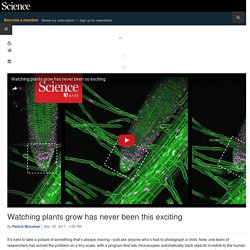
Now, one team of researchers has solved the problem on a tiny scale, with a program that lets microscopes automatically track objects invisible to the human eye. Normally, recording something like a growing plant root would mean days of constant adjustments to a microscope. But with their program, researchers were able to watch the cells in root tips of plants (Arabidopsis thaliana) growing and splitting in 3D over the course of days, they report this month on the preprint server bioRxiv. That required some special equipment: a microscope that uses lasers and fluorescent lights to piece together 3D images, a special lighting system to keep the plants healthy during their longer-than-usual time in the spotlight, and a microscope setup flipped entirely on its side so the plants could grow upright instead of growing horizontally along a slide. Watching plants grow has never been this exciting. This video perfectly explains why CRISPR really will change the world forever.
We've heard a lot about genetic engineering over the past two decades - and, lately there's been even more hype about a new molecular tool called CRISPR, which acts like a cut-and-paste tool for our DNA.

But what many of us don't realise is that, after years of talking about it, we're on the verge of a major change for society - one where we can edit genes as easily as we give medication today. As the latest episode of Kurzgesagt so brilliantly explains, just like no one in the '80s believed computers would ever take over everything, most of us today don't really think that genetic editing won't change everything. 15 myths about a healthy diet you need to stop believing. Nowadays there are so many discussions about healthy diets, and there are a lot of different opinions about what to eat, when to eat, and how much to eat.

Some recommendations sound suspicious, and so we start doubting their truth. We at Bright Side decided to do our research and dispel popular myths about healthy eating. Adapted from: ’Healthy Weight Loss,’ ’Health’. This 12-year-old just trolled anti-vaxxers in the most brilliant way. It's usually not a good start to the day when you log into Facebook and see a video called, "Vaccines DO cause autism" going viral.
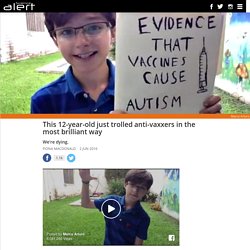
But in this case, 12-year-old Marco Arturo has used the sensationalist headline to troll anti-vaxxers in the most spectacular fashion. Want evidence that vaccines cause autism? Oh just you wait, he's got a whole folder of it for you. Mexican-born Arturo has a whole Facebook page devoted to science and, within a couple of days, his video had already received more than 1 million views, which he adorably explained is "more than the population of Bahamas, Belize, Greenland, Monaco, Bermuda, and Dominica combined. Printable Punnett Square Worksheets. Kinaesthetic lesson on Smoking Related Diseases. Transcribe and Translate a Gene. SEPUP Protein Synthesis Simulation. Diseases - Home. Homeostasis - Mrs J's Science. The key ideas related to a control system includes: purpose of the systemcomponents of the systemmechanism of the system (how it responds to disruption by the normal environmental range of fluctuations)potential effect of major disruption to the system by environmental conditions, disease or infection, drugs, or toxins, or internal influences such as genetic conditions or metabolic disorders.

AS: 91604 Time allocation: 5 weeks Assessment: Written Research Report Credits: 3 Please follow the link to the current lesson :) (Note, some "lessons" may take more than 1 teaching period) Vocabulary: Here's what 200 calories look like for different foods. Your peanut butter's nutrition label — which states that 2 tablespoons = 188 calories — gives you a general idea of how much you're consuming, but you might put down the spoon altogether when you see what that looks like next to 200 calories of celery, carrots or apples.
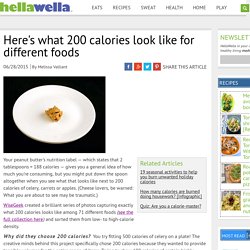
(Cheese lovers, be warned: What you are about to see may be traumatic.) WiseGeek created a brilliant series of photos capturing exactly what 200 calories looks like among 71 different foods (see the full collection here) and sorted them from low- to high-calorie density. Why did they choose 200 calories? You try fitting 500 calories of celery on a plate! The creative minds behind this project specifically chose 200 calories because they wanted to provide tangible volumes for the entire range of items. Jawbone in Rock May Clear Up a Mammal Family Mystery. That Stinky Cheese Is a Result of Evolutionary Overdrive. Photo Like many biologists, Ricardo C.
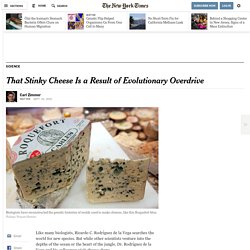
Rodríguez de la Vega searches the world for new species. But while other scientists venture into the depths of the ocean or the heart of the jungle, Dr. Rodríguez de la Vega and his colleagues visit cheese shops. Man walks again after years of paralysis. The ability to walk has been restored following a spinal cord injury, using one's own brain power, according to research published in the open access Journal of NeuroEngineering and Rehabilitation.
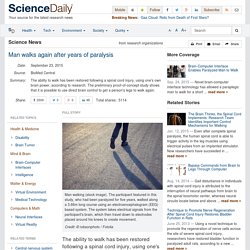
The preliminary proof-of-concept study shows that it is possible to use direct brain control to get a person's legs to walk again. New findings rock long-held assumptions about ancient mass extinction. New evidence gathered from the Karoo Basin in South Africa sheds light on a catastrophic extinction event that occurred more than 250 million years ago and wiped out more than 90 percent of life in Earth's oceans and about 70 percent of animal species on land. In research to be presented Nov. 4 at the annual meeting of the Geological Society of America and published in the October issue of the journal Geology, a University of Texas at Dallas geologist and his colleagues describe new findings that challenge the currently accepted model of the "Great Dying" and how it affected land animals.
Jawbone in Rock May Clear Up a Mammal Family Mystery. Predator Prey. Predator/Prey (also known as the Survival Game or the Game of Life) This is a complicated game but very worthwhile for teaching the girls the basics of ecology and the food chain. In the introduction to the game, you should talk about the relationship between herbivorous (plant-eating), omnivorous (everything-eating) and carnivorous (meat-eating) animals. You should also talk about some possible strategies that the three different types of animals use to survive in nature. Cell Function: Meiosis. What are the big ideas here? There are two cell divisions. Mitosis has one division and meiosis has two divisions. You still have to remember PMATI, but now you do it twice. ScienceAlert. We all know that checking our electronic devices before bed isn't ideal for a good night's sleep, but most of us do it anyway - because what better way is there to end your day than finding out what all your friends did?
But now the video team over at Business Insider has investigated exactly what that behaviour is doing to our brains and bodies, and let's just say we're going to be making a much more concerted effort to keep smartphones out of the bedroom from now on. The problem comes from the fact that your circadian rhythm, which determines when your body releases hormones, is controlled by light exposure, as psychiatrist Dan Siegel from the University of California, Los Angeles in the US tells Business Insider. ScienceAlert. Photographer Frans Lanting's Lyrical Story of Life on Earth. Rescue team untangles baby whale while mother keeps it afloat. Earth - Epic orca and whale battle caught on camera. Food Fight. Omura's whales: Scientists release video of first confirmed sighting of species in wild. Updated For such large animals, Omura's whales are one of the most mysterious and elusive species in the world.
The species of whale was only discovered recently and had never been seen alive in the wild — until now. But now an international team of scientists, led by Salvatore Cerchio of the New England Aquarium and Woods Hole Oceanographic Institution, have released the first ever images and field observations of the little-known species of whale. In a paper published in the Royal Society Open Science journal, the researchers made observations about the Omura's foraging techniques, vocalisations and habitat preferences by examining a population off the coast of Madagascar.
Growing resistance to antibiotics poses a deadly risk to surgery patients, study finds. Rising resistance to antibiotics is an alarming health trend around the world, and now new research on infections stemming from otherwise successful medical procedures highlights how serious the risks are for patients. What kind of Animal is This? Online Animal games for kids! Sheppard Software.
Evolution in Action. What your father did before you were born could influence your future health. This article was written by Paul Haggarty from the University of Aberdeen, and was originally published by The Conversation. How decaf coffee is made. Speciation powerpoint. Examining Convergent Evolution Toothpick%20Birds.pdf.
Watch: Here’s what happens to your brain when you laugh.